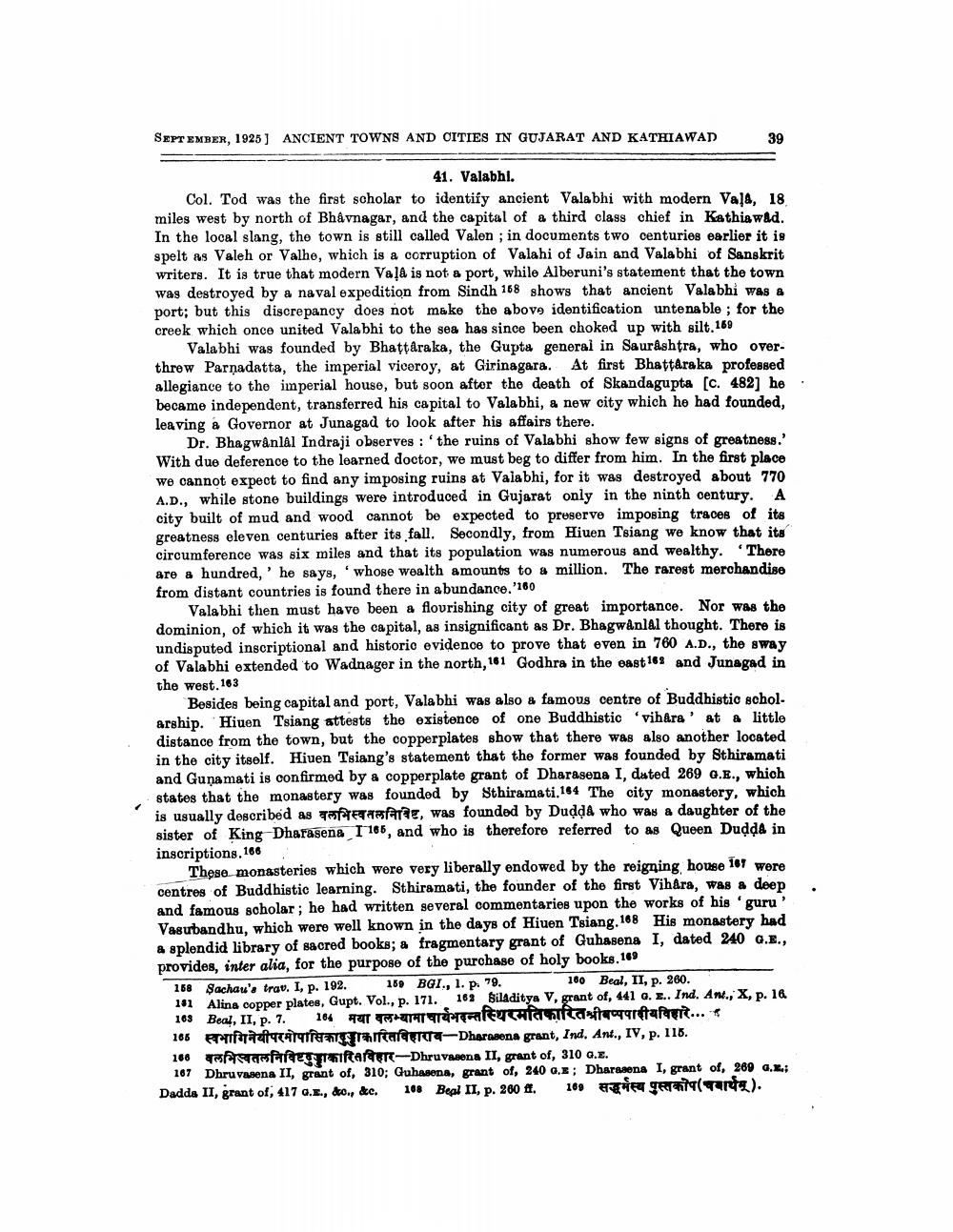________________
SEPTEMBER, 1925] ANCIENT TOWNS AND CITIES IN GUJARAT AND KATHIAWAD
39
41. Valabhi.
Col. Tod was the first scholar to identify ancient Valabhi with modern Vala, 18 miles west by north of Bhavnagar, and the capital of a third class chief in Kathiawad. In the local slang, the town is still called Valen; in documents two centuries earlier it is spelt as Valeh or Valhe, which is a corruption of Valahi of Jain and Valabhi of Sanskrit writers. It is true that modern Vala is not a port, while Alberuni's statement that the town was destroyed by a naval expedition from Sindh 168 shows that ancient Valabhi was a port; but this discrepancy does not make the above identification untenable; for the creek which once united Valabhi to the sea has since been choked up with silt.169
Valabhi was founded by Bhattaraka, the Gupta general in Saurashtra, who overthrew Parnadatta, the imperial viceroy, at Girinagara. At first Bhattaraka professed allegiance to the imperial house, but soon after the death of Skandagupta [c. 482] he became independent, transferred his capital to Valabhi, a new city which he had founded, leaving a Governor at Junagad to look after his affairs there.
Dr. Bhagwânlâl Indraji observes the ruins of Valabhi show few signs of greatness." With due deference to the learned doctor, we must beg to differ from him. In the first place we cannot expect to find any imposing ruins at Valabhi, for it was destroyed about 770 A.D., while stone buildings were introduced in Gujarat only in the ninth century. A city built of mud and wood cannot be expected to preserve imposing traces of its greatness eleven centuries after its fall. Secondly, from Hiuen Tsiang we know that its circumference was six miles and that its population was numerous and wealthy. There are a hundred,' he says, whose wealth amounts to a million. The rarest merchandise from distant countries is found there in abundance. '160
Valabhi then must have been a flourishing city of great importance. Nor was the dominion, of which it was the capital, as insignificant as Dr. Bhagwanlal thought. There is undisputed inscriptional and historic evidence to prove that even in 760 A.D., the sway of Valabhi extended to Wadnager in the north, 161 Godhra in the east 163 and Junagad in the west. 163
Besides being capital and port, Valabhi was also a famous centre of Buddhistic scholarship. Hiuen Tsiang attests the existence of one Buddhistic vihara' at a little distance from the town, but the copperplates show that there was also another located in the city itself. Hiuen Tsiang's statement that the former was founded by Sthiramati and Gunamati is confirmed by a copperplate grant of Dharasena I, dated 269 G.E., which states that the monastery was founded by Sthiramati.164 The city monastery, which is usually described as framfarae, was founded by Dudda who was a daughter of the sister of King Dharasena I 166, and who is therefore referred to as Queen Dudda in inscriptions. 166
These monasteries which were very liberally endowed by the reigning, house 167 were centres of Buddhistic learning. Sthiramati, the founder of the first Vihara, was a deep and famous scholar; he had written several commentaries upon the works of his 'guru Vasubandhu, which were well known in the days of Hiuen Tsiang. 168 His monastery had a splendid library of sacred books; a fragmentary grant of Guhasena I, dated 240 G.E., provides, inter alia, for the purpose of the purchase of holy books. 169
100 Beal, II, p. 260.
158 Sachau's trav. I, p. 192. 159 BGI., 1. p. 79. 162 Siladitya V, grant of, 441 G. E.. Ind. Ant., X, p. 16. 181 Alina copper plates, Gupt. Vol., p. 171.. 163 Beal, II, p. 7. 164 मया वलयामा कार्यरत स्थिरमतिकारित श्रीवाया... 106 स्वभागिनेयीपरमोपासिकादुड्डाकारितविहाराज - Dharasenas grant, Ind. Ant, IV, p. 115.
166 बलभिस्वतलनिविष्टवुड्डाकारित विहार - Dhruvasena II, grant of, 310 a.x.
167 Dhruvasena II, grant of, 310; Guhasena, grant of, 240 G.; Dharasena I, grant of, 269 a.m.; Dadda II, grant of, 417 G.E., &c., &c. 108 Beal II, p. 260 ff. 100 eden gerade(wards).




